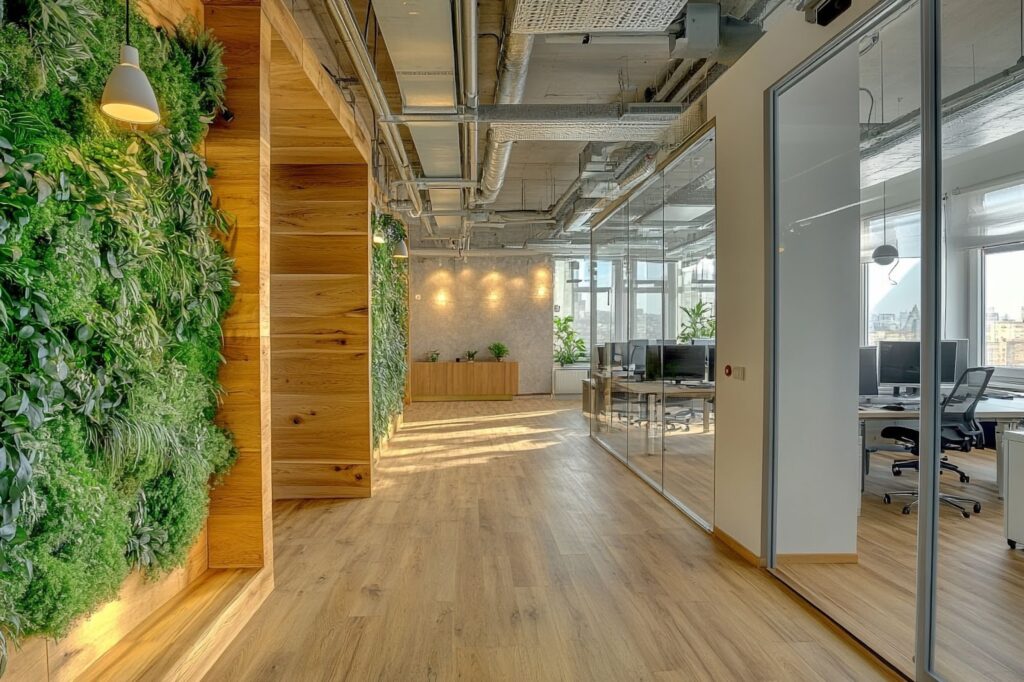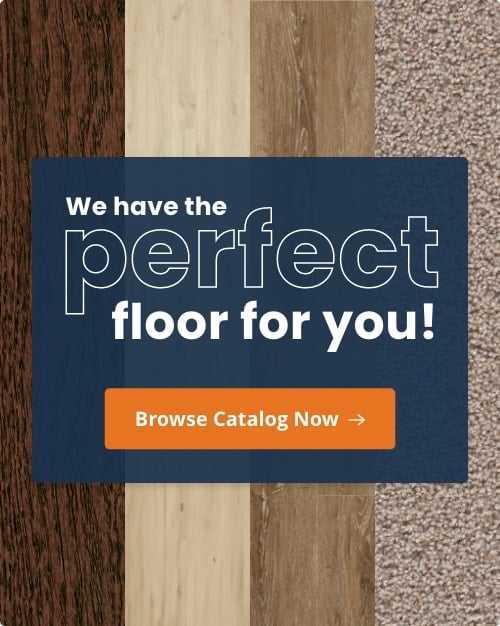

Across the globe, homeowners are rethinking what “beautiful” means when it comes to interiors. It’s no longer just about the finish or the color, it’s about how the materials beneath your feet are sourced, made, and maintained. Sustainable flooring has moved from niche Pinterest boards to mainstream renovation projects, and for good reason.
After years of fast-reno culture seeing a shift toward forever flooring: materials that not only elevate your home’s style but also stand the test of time and tread lightly on the planet. Eco-friendly floors tend to last longer, emit fewer chemicals, and create healthier indoor spaces for families and pets alike.
And the numbers back it up. According to a recent industry report, homeowners who choose renewable or recycled flooring materials can reduce their renovation’s carbon footprint by up to 40%. Even small swaps, like opting for bamboo over traditional hardwood, make a measurable difference.
So if you’re dreaming of a space that’s as responsible as it is beautiful, sustainable flooring is where it all begins. Because style fades, but thoughtful design? That lasts for generations.
What Makes a Floor ‘Sustainable’? (And What Greenwashing Looks Like)
To know the difference, you have to look beneath the surface. Sustainable flooring isn’t defined by trendy labels or earthy packaging. It’s about how the material is grown, harvested, manufactured, transported, and eventually disposed of. In other words, sustainability starts long before that floor reaches your home and continues long after it’s installed.
So what makes a floor genuinely sustainable? It comes down to a few key factors:
1. Renewability
A sustainable floor begins with a material that can be renewed or replenished faster than it’s consumed. Bamboo is one of the best examples: it’s technically a grass, and it can grow to full maturity in just three to five years.
Compare that to oak or maple trees, which can take decades to reach harvest size. Cork is another renewable winner; it’s harvested from the bark of cork oak trees without ever cutting the tree down. That bark simply grows back, again and again.
When you choose renewable materials, you’re supporting a natural cycle that doesn’t drain the planet’s resources.
2. Recyclability & Reuse
The best eco-friendly materials can be recycled, reclaimed, or even repurposed into new products instead of ending up in a landfill.
Reclaimed wood, for example, gives new life to old barns, factories, or warehouses. It carries history, character, and a smaller environmental footprint because no new trees are cut down to produce it.
Linoleum, not to be confused with vinyl, is another standout. It’s made from natural ingredients like linseed oil and jute, and it’s biodegradable at the end of its lifespan. That means less waste, less guilt, and more circular design.
3. Low VOC Emissions
You might not see or smell them, but volatile organic compounds (VOCs) can be hiding in the finishes, adhesives, and sealants used in flooring. These compounds off-gas into your home’s air, contributing to indoor pollution,and yes, that new-floor smell isn’t always a good thing.
Low-VOC or VOC-free flooring options help keep your indoor air cleaner and safer for your family. Materials like natural cork, eco-certified vinyl, and water-based sealants are great examples of healthy, breathable home choices. Plus, better indoor air quality means fewer allergens, less irritation, and a fresher-feeling home overall.
4. Responsible Sourcing
Even a natural material can lose its sustainability edge if it’s harvested irresponsibly or shipped halfway around the world using heavy fossil fuels. That’s where certifications come in.
- The Forest Stewardship Council (FSC) ensures wood products come from forests that are responsibly managed and replanted.
- GreenGuard and FloorScore certifications verify that products meet strict standards for low chemical emissions.
- For recycled materials, Cradle to Cradle certification looks at the full product lifecycle, from raw sourcing to recyclability.
When in doubt, look for these third-party stamps of approval. They’re your shortcut to knowing the product was vetted beyond marketing claims.
Spotting Greenwashing: Don’t Fall for the Leaf Logo
Here’s the uncomfortable truth: some brands spend more on looking sustainable than actually being sustainable. That’s called greenwashing, and it’s everywhere.
Words like “eco-conscious” or “earth-inspired” may sound noble, but unless the brand provides transparency about its materials and manufacturing, they don’t mean much. A “natural wood” label might still hide high levels of formaldehyde in the adhesive, or a “sustainable” vinyl might be made using petroleum-based plastics that take centuries to break down.
Even packaging can be misleading. A recycled paper label or green color palette doesn’t guarantee the flooring inside is any better for the planet.
Top Eco-Friendly Flooring Options You’ll Actually Love
Sustainable flooring doesn’t have to mean sacrificing style. Below, we’re spotlighting the most popular planet-friendly materials that deliver both form and function.
Bamboo Flooring
If hardwood had an eco-conscious cousin, it would be bamboo. Technically a grass, bamboo can reach full maturity in just three to five years, making it one of the fastest-renewing resources on the planet. That means you get the beauty and strength of hardwood without the deforestation guilt.
Bamboo comes in several stylish forms: strand-woven for heavy traffic, carbonized for richer, darker tones, and natural for that light, airy look that instantly brightens a room. It’s hard, stable, and refreshingly modern, a favorite among eco-conscious designers.
Pros: Durable, easy to maintain, and sustainable.
Cons: Sensitive to humidity and moisture, so best avoided in bathrooms or basements.
Design Tip: Pair bamboo with neutral walls and clean-lined furniture for a calm, Zen-inspired interior.
Cork Flooring
If comfort underfoot is a priority, cork might just steal your heart. Made from the bark of cork oak trees, which naturally regrow after harvesting, cork is a true renewable superstar. No trees are cut down in the process, making it one of the most sustainable materials out there.
Beyond its green credentials, cork feels luxuriously soft, insulates against noise, and even resists mold and mildew. It’s a dream in bedrooms, playrooms, and home gyms, where warmth and comfort matter most.
Pros: Cork absorbs sound, making it perfect for multi-level homes or apartments.
Cons: Moisture-sensitive, scratches, color-fades, limited-refinishing
Design Tip: Ideal for cozy, Scandinavian-inspired spaces with natural textures and soft lighting.
Reclaimed or Salvaged Wood
There’s something deeply special about reclaimed wood; every plank tells a story. Salvaged from old barns, factories, or heritage buildings, this flooring brings warmth, depth, and one-of-a-kind character to your space.
Eco-wise, reclaimed wood is a major win: it keeps old materials out of landfills and reduces the demand for newly cut timber. You’re literally saving a piece of history and giving it new life under your feet.
You can find authentic reclaimed wood through architectural salvage yards, specialty suppliers, or certified eco-builders who verify ethical sourcing.
Pros: Each plank has one-of-a-kind grain patterns and aged patina.
Cons: Requires periodic sealing or refinishing to preserve its character.
Design Tip: Perfect for farmhouse, rustic, or industrial interiors. Think warm lighting, exposed brick, and vintage furniture.
Vinyl & Linoleum
Forget everything you thought you knew about vinyl, today’s versions are a whole new level of sustainable. Many brands now offer low-VOC vinyl flooring made with recycled content and non-toxic adhesives, giving you that sleek, modern look without compromising air quality.
And then there’s linoleum, the OG of green flooring that’s making a big comeback. Made from linseed oil, wood flour, and jute, it’s 100% biodegradable and naturally anti-static. Plus, it’s available in a huge range of colors and patterns, so you can go bold or stay subtle.
Vinyl vs. Linoleum at a Glance:
| Feature | Eco Vinyl | Linoleum | Traditional LVT |
| Material Source | Recycled plastic, low-VOC | Natural (linseed oil, jute) | PVC-based |
| Durability | High | High | High |
| Sustainability | Moderate | Excellent | Low |
| Design Variety | Wide | Moderate | Wide |
Design Tip: Use modern vinyl for high-moisture areas like kitchens and baths, and linoleum for open living spaces where warmth and air quality matter most.
Natural Stone & Terrazzo
Natural stone is long-lasting, recyclable, and requires minimal processing. That means less energy use and fewer emissions overall.
Then there’s terrazzo, the artistic, speckled flooring you’ve seen all over design magazines. It’s made by embedding recycled stone, glass, or marble chips into cement, creating a surface that’s as beautiful as it is durable.
Because terrazzo lasts for decades (and often outlives the building itself), it’s considered one of the most sustainable luxury flooring options available.
Pros: Made from natural or recycled stone and cement components.
Cons: Requires strong subfloor support and professional installation.
Design Tips: Perfect for modern Mediterranean or art deco spaces. Pair with brass accents, natural light, and organic textiles.
Certifications That Actually Mean Something
Ever notice how every product these days seems to come with a “green” badge or a leaf-shaped logo? It can feel impossible to tell which ones are legit and which are just there to make you feel eco-responsible. The truth is, some certifications actually hold serious weight, while others are nothing more than clever marketing.
If you want to make sure your flooring choice walks the talk, here are the labels that truly matter.
FSC (Forest Stewardship Council)
When it comes to wood, the FSC label is the gold standard. This certification ensures that your flooring comes from responsibly managed forests, meaning for every tree harvested, new ones are planted, and biodiversity is protected. FSC-certified wood also guarantees fair labor practices and traceable sourcing.
Why it matters: It helps you enjoy the warmth of real wood floors without contributing to deforestation. Think of it as nature-approved luxury.
Look for: “FSC 100%” (best option) or “FSC Mix” (partially certified content).
GreenGuard Gold
That “new floor smell” isn’t always a good thing. It can be a sign of VOCs (volatile organic compounds) off-gassing into your home. GreenGuard Gold certification ensures your flooring (and its adhesives or finishes) meets some of the strictest standards for low chemical emissions.
Why it matters: It protects indoor air quality, making your home safer for kids, pets, and anyone with allergies or respiratory sensitivities.
Bonus tip: Pair GreenGuard-certified flooring with low-VOC paints and finishes for a complete clean-air makeover.
FloorScore
Similar to GreenGuard, FloorScore focuses on indoor air quality, but specifically for hard surface flooring materials. It’s backed by independent laboratory testing, so you know you’re getting third-party validation, not just a brand’s promise.
Why it matters: FloorScore-certified products qualify for LEED credits (more on that below), which can boost the eco rating of your home or project.
Cradle to Cradle Certified
This one goes beyond just how a product is made, it evaluates the entire lifecycle. A Cradle to Cradle certification looks at a material’s safety, recyclability, energy efficiency, water usage, and even social impact.
Why it matters: It’s one of the most forward-thinking certifications out there. If you see this logo, you’re choosing a floor that’s designed not just for today, but for a sustainable future.
LEED (Leadership in Energy and Environmental Design)
If you’ve ever toured a “green” building, you’ve probably heard of LEED. While it’s not a product certification, it’s the benchmark for sustainable construction worldwide. Choosing LEED-friendly flooring like FSC-certified wood or FloorScore vinyl, can help earn points toward LEED certification for your home or renovation project.
Why it matters: LEED isn’t just about bragging rights; it can increase your property value and lower your environmental footprint.
Pro Tip: How to Spot Greenwashing and Fake Labels
Unfortunately, not every “eco” claim is honest. Here’s how to separate the real from the fake:
- Look for third-party verification. Real certifications are backed by independent organizations, not created by the brand itself.
- Research the certifier. If you’ve never heard of a label, do a quick search. Legit organizations like FSC and GreenGuard have transparent websites and trackable product lists.
- Beware of vague language. Phrases like earth-friendly, eco-smart, or sustainably inspired don’t mean anything without proof.
- Check the fine print. Real certifications will have a registration number or product ID you can verify online.
The Hidden Perks of Going Green
Sure, sustainable flooring helps the planet, but the perks go way beyond environmental feel-good points. The truth is, choosing eco-friendly materials can make your home healthier, quieter, and even more valuable.
Cleaner Air, Healthier Living
Many traditional floors, especially those made with synthetic glues or finishes, release VOCs (volatile organic compounds) into your home’s air for months, sometimes even years. That “new floor smell”? Often a cocktail of chemicals.
Eco-friendly flooring, on the other hand, keeps things fresh. Materials like bamboo, cork, and linoleum are naturally low in VOCs and don’t trap dust or allergens, which makes them ideal for families with kids, pets, or anyone prone to allergies. You’ll breathe easier knowing your home’s air is cleaner and safer.
Naturally Energy-Efficient
Cork flooring, for example, acts like a built-in insulator, keeping floors warmer in the winter and cooler in the summer. That means less reliance on heating and air conditioning, and lower energy bills over time.
Even materials like reclaimed wood and eco-friendly vinyl retain warmth better than ceramic tiles, making your home feel cozier underfoot.
Boosting Resale Value the Smart Way
Sustainability isn’t just a personal choice anymore, it’s a selling point. Homebuyers are increasingly asking about air quality, certifications, and green materials. Installing eco-conscious flooring now could give you an edge later if you decide to sell.
Real estate data backs it up: homes featuring sustainable design elements can command higher resale values and spend less time on the market. Think of it as an investment that pays you back in both comfort and value.
Daily Maintenance Hacks That Make Floors Last Longer
Sustainable floors may be tough, but they’re not invincible. Small, consistent habits are the secret to keeping them beautiful for decades.
- Sweep or vacuum regularly. Dirt and grit act like sandpaper on your finish, especially with softer materials like cork or strand-woven bamboo.
- Add felt pads to furniture legs. It’s an easy, inexpensive way to prevent dents and scratches and to save your floor from that awful scraping sound.
- Keep humidity balanced. Natural materials breathe with your environment. Too dry, and they can crack; too humid, and they might swell. A simple dehumidifier or indoor plant balance can make all the difference.
One of the best things about sustainable flooring is that it’s designed to be revived, not ripped out. With a few small touch-ups, you can restore their original luster without creating more waste.
- Bamboo: When surface wear appears, lightly sand and reseal using a water-based polyurethane for a fresh, glossy finish that’s still eco-safe.
- Cork: Every few years, apply a new non-toxic sealant to maintain its moisture barrier and natural cushion. This keeps it soft underfoot while preventing water damage.
- Vinyl (Eco or Recycled): Use a plant-based polish or mild soap to bring back its sheen. Avoid wax-based products, they can leave a film that attracts more dirt.
Budget-Friendly Ways to Go Green Now
Who says going green has to mean spending more? Building a sustainable home is as much about how you use what you already have as it is about what you buy next. Here are some easy, affordable ways to make your floors (and your budget) a little more eco-happy:
Refinish Instead of Replace
If your floors still have good bones, skip the total overhaul. A light sanding and a fresh coat of low-VOC or water-based finish can make even decades-old wood look brand new. Not only does this save money, but it also keeps tons of material out of landfills.
Add Recycled or Natural Rugs
Instead of synthetic area rugs that trap dust and off-gas chemicals, try rugs made from organic cotton, jute, or recycled fibers. They add warmth, color, and sound absorption minus the toxins. Bonus: they’re biodegradable and often machine-washable.
DIY Your Finishes
If you’re feeling handy, you can even mix your own natural floor treatments using beeswax, olive oil, or linseed oil blends. These old-school finishes nourish wood and cork without the fumes. Think of it as self-care for your floors.
Shop Smart, Not Hard
There’s a growing lineup of eco-conscious brands offering affordable, planet-friendly flooring and accessories. From low-VOC vinyl planks to FSC-certified wood, there’s an option for every space and budget.
Final Word
At the end of the day, sustainable design isn’t about perfection, it’s about intention. It’s the conscious choice to build a space that supports your health, respects the planet, and feels good to live in.
You don’t need to redo your entire house overnight. Maybe it starts with a cork floor in the bedroom, a reclaimed wood accent in the living room, or swapping out harsh cleaners for green alternatives.
Because when it comes to sustainability, every step counts. So why not start with the very ones you take every day, your floors?
At 50Floor.com, finding the perfect eco-friendly floor is easier than you think. From sleek bamboo and soft cork to modern low-VOC vinyl, their curated collection lets you design a home that’s both beautiful and kind to the planet. It’s living proof that sustainable choices can be every bit as stylish, and feel just as good underfoot.



